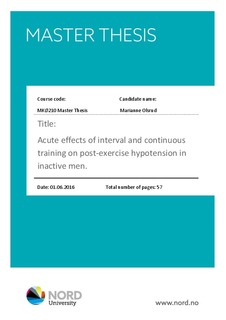Acute effects of interval and continues training on post-exercise hypotension in inactive men.
Master thesis
Permanent lenke
http://hdl.handle.net/11250/2396338Utgivelsesdato
2016-07-12Metadata
Vis full innførselSamlinger
Sammendrag
Purpose: This study investigated the effects of isocaloric high-intensity interval training and moderate intensive continuous training on post-exercise hypotension (PEH) in inactive men, hence it is possible to be specific to the effect of intensity on the PEH response. It is hypothesized that high-intensity interval training would give a greater extent and duration than moderate intensity endurance training on the PEH response and that total peripheral resistance (TPR) and stroke volume (SV) is lower after training with high-intensity than training with moderate intensity. Method: Six physically inactive men (age: 52.0 ± 7.8 year; maximal oxygen uptake (VO2max): 35.6 ± 7.3 ml kg-1 min-1) volunteered to participate in this study. Results: The main findings showed that SBP and MAP changed significantly over time (independent of type of training) (p<0.001), but DBP showed no significant differences. TPR, CO, HR and SV changed significantly over time (p<0.001) and HR was the only one who showed significantly differences between interval and continuous training, where interval training had greater HR after 10 min PE. The present study did not find any significant different between interval and continuous training on SBP, DBP and MAP in the PE period.
Conclusion: This study indicates that high-intensity interval training and moderate intensive continuous training at same calorie consumption had similar PEH responses. Individuals with mild hypertension can use both training types to get a PEH response and prevent higher BP.
